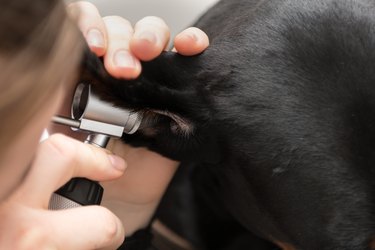If your dog is frequently shaking their head and pawing at an itchy ear, it's not unusual to find a swelling in their ear flap known as a hematoma. An ear hematoma develops when a vein or capillary leaks blood, collecting between the skin and cartilage of the ear flap. Don't attempt to drain your dog's ear hematoma at home. Ear hematomas in dogs are usually caused by an underlying condition, like an ear infection or allergies. So, it's important to schedule a visit with your veterinarian.

Video of the Day
What causes ear hematomas in dogs?
Also called an aural hematoma, ear hematomas in dogs develop when an ear infection, allergies, or ear mites cause a dog to excessively scratch at their ears and shake their head (it's often the shaking that breaks blood vessels). Ear scratching and head shaking causes a broken blood vessel in the ear flap, causing a hematoma to form. As opposed to bruising, an ear hematoma is a pocket of blood and blood clots between the skin and the cartilage of the dog's ear flap.
Video of the Day
Symptoms of dog ear infections or ear hematomas
Symptoms of ear hematomas often resemble that of an ear infection. You may notice the following symptoms if your dog has an ear hematoma or an ear infection:
- Excessive headshaking from the ear being irritated
- Swollen ear flap
- Ear flap warm to the touch
- Discharge from the ear

What happens when a dog ear hematoma is left untreated?
When left untreated, the hematoma can cause scarring and narrowing or obstruction of the outer ear canal, permanently damaging a dog's hearing. Severe scarring and wrinkling can also develop, a condition called cauliflower ear.
The swelling can feel like a water balloon and might be heavy enough to cause the ear to droop abnormally. When swelling blocks the ear canal completely, the dog's hearing can be impacted. Because the swelling induced by a hematoma causes pain and may contribute to infection of the ear canal, it must be treated by a veterinarian.
At-home treatments for ear hematomas in dogs
Hematomas may eventually heal on their own when the underlying condition is treated. But if your dog's hematoma is causing discomfort or pain, it must be treated by a veterinarian. Ear hematomas in dogs can take several months to heal, and when left untreated, they can result in scar tissue and permanent damage to the ear.
If you find a swelling that you suspect is a hematoma, schedule a vet visit. It's crucial to diagnose and treat the underlying cause of the hematoma, such as discomfort from an underlying ear infection, ear mites, or allergies.
While you're waiting to see the veterinarian, make your pup more comfortable by trying a simple and safe home remedy like applying a cold compress. If applying a cold compress causes your dog pain or if the hematoma gets larger or more inflamed, stop at-home care and let your veterinarian know immediately. Additionally, using an Elizabethan collar (e-collar) will prevent your dog from scratching their ears and further irritating the ear hematoma.

How veterinarians treat ear hematomas in dogs
Don't attempt to drain your dog's ear hematoma at home. If the hematoma is small, your veterinarian may treat the underlying cause and allow the ear hematoma to heal on its own. Without treatment of the underlying cause, the ear hematoma will not heal or will come back. To treat the underlying cause, your veterinarian may prescribe topical or oral medication for ear mites, allergies, or ear infections.
Large hematomas causing pain or blocking the ear canal require treatment. Your veterinarian may choose surgical treatment, including draining and suturing the ear hematoma. Local or oral steroids may also be prescribed by your veterinarian for ear hematoma treatment in dogs.
The bottom line
Ear hematomas, also called aural hematomas, develop when scratching and shaking of the ear breaks blood vessels. The blood and blood clots pool between the skin of the ear and its cartilage, forming a blood blister-like swelling called an ear hematoma. If your dog develops a hematoma, they should always be seen by your DVM to treat the underlying condition, which is usually mites, an ear infection, or allergies. Small hematomas in dogs may heal on their own when the underlying condition has been treated. Larger hematomas can cause pain, secondary infections, severe scarring, cauliflower ear, and even loss of hearing. Your veterinarian will decide the best treatment option for a large hematoma, which may include surgical drainage or steroids.